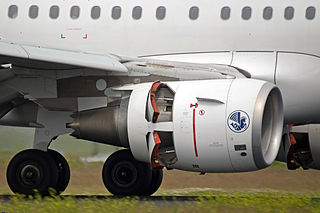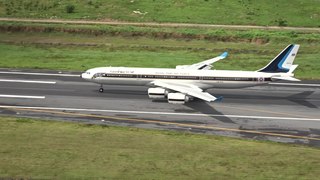
Taxiing is the movement of an aircraft on the ground, under its own power, in contrast to towing or pushback where the aircraft is moved by a tug. The aircraft usually moves on wheels, but the term also includes aircraft with skis or floats.

Takeoff is the phase of flight in which an aerospace vehicle leaves the ground and becomes airborne. For aircraft traveling vertically, this is known as liftoff.
In aviation, a go-around is an aborted landing of an aircraft that is on final approach or has already touched down. A go-around can either be initiated by the pilot flying or requested by air traffic control for various reasons, such as an unstabilized approach or an obstruction on the runway.

Thrust reversal, also called reverse thrust, is the temporary diversion of an aircraft engine's thrust for it to act against the forward travel of the aircraft, providing deceleration. Thrust reverser systems are featured on many jet aircraft to help slow down just after touch-down, reducing wear on the brakes and enabling shorter landing distances. Such devices affect the aircraft significantly and are considered important for safe operations by airlines. There have been accidents involving thrust reversal systems, including fatal ones.

In aviation, a touch-and-go landing (TGL) or circuit is a maneuver that is common when learning to fly a fixed-wing aircraft. It involves landing on a runway and taking off again without coming to a full stop. Usually the pilot then circles the airport in a defined pattern known as a circuit and repeats the maneuver. This allows many landings to be practiced in a short time.

USAir Flight 405 was a regularly scheduled domestic passenger flight between LaGuardia Airport in Queens, New York City, New York, and Cleveland, Ohio. On March 22, 1992, a USAir Fokker F28, registration N485US, flying the route, crashed in poor weather in a partially inverted position in Flushing Bay, shortly after liftoff from LaGuardia. The undercarriage lifted off from the runway, but the airplane failed to gain lift, flying only several meters above the ground. The aircraft then veered off the runway and hit several obstructions before coming to rest in Flushing Bay, just beyond the end of the runway. Of the 51 people on board, 27 were killed, including the captain and a member of the cabin crew.

The Learjet 25 is an American ten-seat, twin-engine, high-speed business jet aircraft manufactured by Learjet. It is a stretched version of the Learjet 24.

USAir Flight 5050 was a passenger flight that crashed on takeoff from LaGuardia Airport in Queens, New York. As the plane took off from LaGuardia's runway 31, the plane drifted to the left. After hearing a loud bang, the pilots attempted to reject the takeoff, but were unable to stop the plane short of the end of the runway. The plane continued past the end of the runway and plunged into Bowery Bay. Two passengers were killed.
In aviation, a balanced field takeoff is a condition where the takeoff distance required (TODR) with one engine inoperative and the accelerate-stop distance are equal for the aircraft weight, engine thrust, aircraft configuration and runway condition. For a given aircraft weight, engine thrust, aircraft configuration, and runway condition, the shortest runway length that complies with safety regulations is the balanced field length.

Jackson County Airport, also known as Reynolds Field, is a county-owned, public-use airport located two nautical miles (3.7 km) west of the central business district of Jackson, in Jackson County, Michigan, United States. It is a class D airport with operating control tower. It is included in the Federal Aviation Administration (FAA) National Plan of Integrated Airport Systems for 2017–2021, in which it is categorized as a regional general aviation facility.
In aviation terminology, a rejected takeoff (RTO) or aborted takeoff is the situation in which the pilot decides to abort the takeoff of an airplane after initiating the takeoff roll but before the airplane leaves the ground.

Trans World Airlines (TWA) Flight 159 was a regularly scheduled passenger flight from New York City to Los Angeles, California, with a stopover in Cincinnati/Northern Kentucky International Airport, Kentucky, that crashed after an aborted takeoff from Cincinnati on November 6, 1967. The Boeing 707 attempted to abort takeoff when the copilot became concerned that the aircraft had collided with a disabled DC-9 on the runway. The aircraft overran the runway, struck an embankment and caught fire. One passenger died as a result of the accident.

TWA Flight 843 was a scheduled Trans World Airlines passenger flight that crashed after an aborted takeoff from John F. Kennedy International Airport to San Francisco International Airport (California) in July 1992. Despite an intense fire after the crash, the crew was able to evacuate all 280 passengers from the aircraft. There was no loss of life, although the aircraft was destroyed by the fire.

A turbine engine failure occurs when a turbine engine unexpectedly stops producing power due to a malfunction other than fuel exhaustion. It often applies for aircraft, but other turbine engines can fail, like ground-based turbines used in power plants or combined diesel and gas vessels and vehicles.

Waukegan National Airport is a public airport in Waukegan, in Lake County, Illinois. The airport is 40 miles (64 km) north of Chicago. It was originally Waukegan Memorial Airport. It has been operated by the Waukegan Port District since 1956 and is the second busiest airport in Illinois for international arrivals. In January 2014 under a FAA reclassification of many small airports, the airport was renamed Waukegan National Airport
Grand Haven Memorial Airpark is a public airport owned and operated by the City of Grand Haven located 2 miles (3.2 km) southeast of Grand Haven, Michigan. The airport is uncontrolled, and is used for general aviation purposes. It is included in the Federal Aviation Administration (FAA) National Plan of Integrated Airport Systems for 2017–2021, in which it is categorized as a local general aviation facility.

In aviation, V-speeds are standard terms used to define airspeeds important or useful to the operation of all aircraft. These speeds are derived from data obtained by aircraft designers and manufacturers during flight testing for aircraft type-certification. Using them is considered a best practice to maximize aviation safety, aircraft performance, or both.
Medina Municipal Airport is a public use airport in Medina County, Ohio, United States. It is owned by the City of Medina and is located four nautical miles (7.41 km) east of the city's central business district. According to the FAA's National Plan of Integrated Airport Systems for 2007-2011, it is categorized as a reliever airport.

RwandAir Flight 205 was a Canadair CRJ100 that crashed into the Terminal Building after an emergency landing at Kigali, Rwanda killing one passenger. The flight was operated by JetLink Express on behalf of RwandAir. In the aftermath of the accident, RwandAir suspended all operations with JetLink Express.
Weltzien Skypark is a privately owned, public use airport located 3 miles west of Wadsworth, Ohio in Medina County. The airpark sits on 26 acres at an elevation of 1210 feet.













